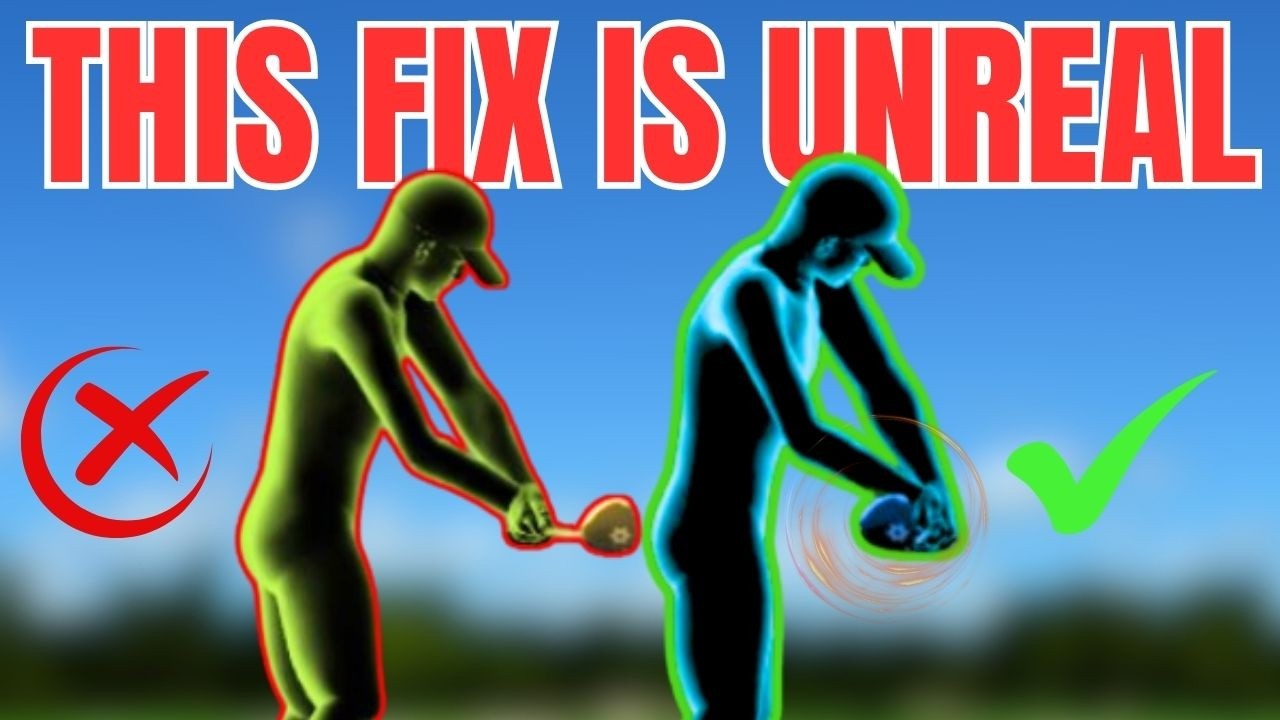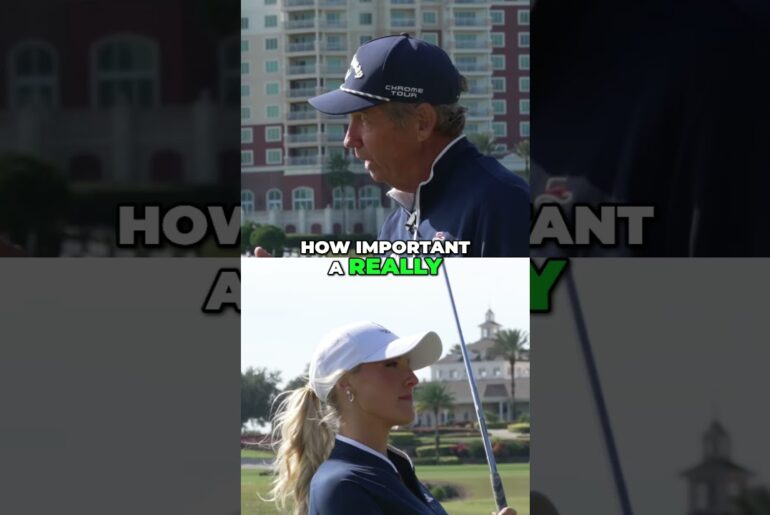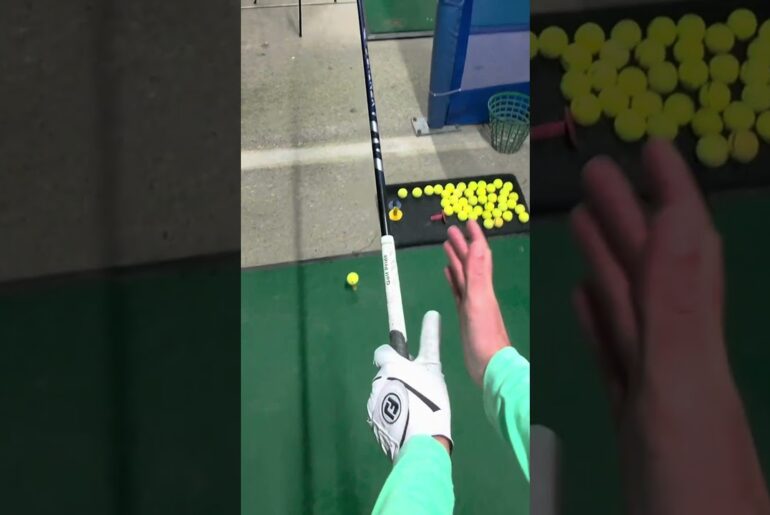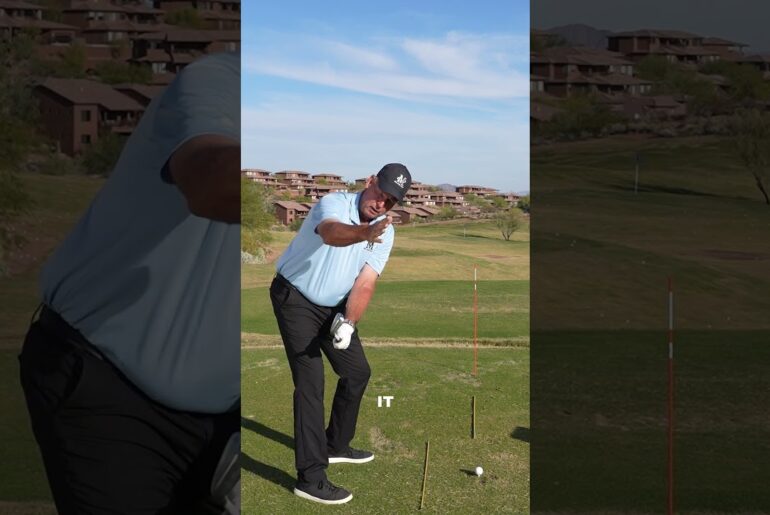Struggling with a golf slice off the tee? In this golf lesson, we take Liam from a severe out-to-in path and weak fade to a much more neutral club path and straighter ball flight — all with one simple driver swing change.
You’ll see exactly how adjusting trail knee rotation and foot flare transformed his club path from 16° out-to-in to nearly square, improving attack angle, strike quality, and distance. Using Swing Catalyst data from the JD Golf Academy, we break down the before-and-after numbers so you can copy this move for your own driver golf swing basics.
Whether you fight a slice, hit weak fades, or lose distance because of poor body rotation, this drill will help you:
* Reduce excessive trail knee rotation
* Control sway and improve weight shift
* Use horizontal ground forces for more speed
* Neutralise your club path for straighter shots
This is one of the simplest and most effective driver golf swing tips you’ll ever try — and you can practice it both at home and on the range.
Question for you: When was the last time you took a golf lesson, and what did you work on? Let us know in the comments.
Subscribe for more free golf tips every week!
—–
SAVE MONEY and support the channel by using my affiliate links.
I’ve partnered with top companies to offer discounts on launch monitors, training aids, range finders, and more.
Check out all my affiliate deals here:
https://crossfieldgolf.info/Affiliate-Discounts
—–
Sign up for my FREE golf tips newsletter:
https://www.crossfieldgolf.com/
—–
Welcome to the Mark Crossfield Golf channel, your ultimate destination for all things golf! Whether you’re a beginner just learning how to swing a golf club or a seasoned golfer aiming to refine your golf swing, this channel is here to help you master every aspect of your golf swing. With a blend of expert golf instruction, golf tips, practical golf lessons and honest equipment reviews, Mark Crossfield provides you with everything you need to play your best golf.
At Mark Crossfield Golf, we know that mastering your golf swing and perfecting your golf grip are fundamental to becoming a better golfer. Our videos dive deep into the essentials of a solid golf swing, teaching you how to swing a golf club with precision and power. From golf swing basics to advanced golf swing drills and techniques, we cover it all.
Our channel offers a wide range of golf lessons tailored to golfers of all skill levels. If you’re new to the game, our beginner golf content will guide you through the fundamentals, including the golf grip, golf stance, and how to execute a consistent golf swing. For more experienced players, we provide advanced golf lessons on topics like ball striking and perfecting your golf swing. Each golf lesson is designed to be practical and actionable, so you can apply what you learn directly on the golf course and start seeing results.
Choosing the right equipment is crucial for any golfer. We provide thorough reviews of the best drivers and best irons to help you make informed decisions. Whether you’re searching for the best drivers for beginners or looking for high-performance golf clubs that can take your game to the next level, our reviews cover all the top options. Learn about the latest golf technology and discover which equipment is best suited for your game style.
Every golfer knows that small adjustments can make a big difference. Our channel offers a wealth of golf swing tips designed to help you improve every part of your golf game. Learn how to hit the driver straight, avoid common mistakes, and develop a strategy for better golf shots. We provide detailed advice on mastering your short game and putting, ensuring you’re equipped with the skills needed to lower your scores.
Understanding the mechanics of your golf swing is key to improvement. Our slow motion golf swing analysis breaks down each part of the swing, helping you identify areas for refinement. By performing slow motion golf swing analysis, you can make precise adjustments that lead to more consistent and powerful golf shots.
At Mark Crossfield Golf, we believe in building a community of passionate golfers. Join us as we explore every aspect of golf, from golf swing basics to golf lessons for advanced players. We encourage you to leave comments, ask questions, and share your experiences. Our community is all about learning, growing, and enjoying the game of golf together. By engaging with our content, you’ll gain access to the best golf tips, golf lessons, golf swing advice and equipment reviews available.
Don’t miss out on the latest videos designed to help you improve your golf swing. By subscribing to our channel, you’ll receive regular updates on new golf tips, golf lessons, golf swing drills, and equipment reviews.
getting past. Oh yes, blocky. You want to
find out how we made such huge changes with Liam from getting him from this position to that
position in such a short time? This is the video for you. It’s going to help you understand how
you hit your drive straighter longer every time. And it’s done with a real simple trigger that
might surprise you. Hope you enjoy this one. Question for today’s video. So, when was the last
time you took a lesson and what did you work on? Let me know in the comments. Right knee at the
address position. So, we’ve got 20° of rotation to the right knee. And then you’ve got 11° of
rotation of the trail ankle. So, trail ankle turned out a lot. Flared a lot. Now, the whole
premise of Liam is we’re looking to influence his swing direction. Yeah. Cuz club path was getting
up to 16 and 10 out to him. So, when he squares the face to that, he hits the pull. When the face
is obviously right of that, he hits the big weak left to right. So the goal of today’s lesson for
Liam is to get him not so far from the outside on the way down and obviously through impact, not so
far down. So if we can change his angle of attack, we can change his club path, he’s going to hit
it considerably better and longer. So we can see at the top of the action like that right knee is
fun 54 degrees rotated compared to a torpro that is 27. Yeah that’s amazing. So there is rotation
in the right knee. Yeah. It’s just considerably less. And then in turn if you just take them
to impact you can see that Liam just doesn’t get across. Yeah. So he’s too far right too late.
Correct. So he’s too far behind the ball too late. Yeah. So if you’re adding in more rotation Yeah.
He’s the classic over the top action. Yeah. Yeah. And obviously the more more lateral we can add
in Yeah. the more that’s going to dampen push the path out towards. Yeah. Should we have a play?
So without the ball for me there, Liam, just have a practice swing. Basically, don’t make a down
swing. Just go up to the top of the back swing. Can you point your knee at me in the camera here?
Okay. So, trail knee at the moment is pointing at the desk. Can you bring that trail knee in towards
Yeah. So, let the right leg straighten. Just try not to rotate the right leg so much. Still. There
you go. That’s better. So, you’re now less behind the ball. Any shift towards the target this way
is going to be winning where you were with the right knee facing kind of the stricksen. Well,
that’s convenient. How awkward. The strixen logo. I just want to stop it there. Look what Liam
does to his feet. See how he selfassesses? He self adjusts with his feet. Turns lead foot out
more. Trail foot straightens up to try and make sure his body is going to move that way. Less sway
to tidy up his knee. He kind of self-discovered that. I love that in lessons. Yeah, that’s what
we want. And we can see on the Swing Cat software here that that’s where we were. Well, if you
looked at um Liam’s horizontal, which is the force we’re looking to get up. Yeah. I mean,
it’s so weak. Yeah. He’s not using horizontal force. He can’t kick off his right foot at all.
Yeah. Which is obvious from that position at the top. Yeah. Absolutely. Like he is not even That’s
not a position that’s built to go that way. Yeah. Yeah. So, look, club paths down to eight
out already. It was 16 on a couple of them. It’s literally having it with with a one for
on the way back. There’s more that can be done. Yeah. Yeah. Yeah. Absolutely. So again,
turn the foot in resisting the right knee. So yeah, look, big jump. 12 13 8 7 Yeah. So
it’s 40% better already. Yeah. So you’re giving yourself a chance of doing what you want to do
on the down swing. Yeah. Like you’re you’re just giving yourself a go. It doesn’t mean it’s
going to make it happen. You could still get across more and do all the other things that you
guys worked on. Yeah. But with that runaway knee, you’re giving yourself no chance. You would
have to be the best athlete we have ever seen to recover that position. Well, you can’t you can’t
add right side tilt in that point. We need to add right tilt in. Yeah. Exactly. Which is going
to make that club come from a different path. So top of back swing midpoint of lesson here
you’re 44 knee turn where you were 52 and the right ankle significantly better and the right
ankle significantly better. What happened to any sway with that shift in the way he turned the
right knee much less sway off the ball in the back swing. What are they call them out for us?
N negative after. So he’s away or towards target? Away slightly still away from target versus whole
two inches. So he’s his shift is changing. So he’s not swaying off the ball as much. And then by
contact we’re negative.3 in terms of sway which we’d want to see two to four across, wouldn’t
we? Minimum. Yeah. Versus 1.6 positive. Oh, we’re getting there. That’s why that shifted. That’s why
path is down. Not even having to think about path. you that will just fix path but to you I presume
the surprising thing is that is still 44 rotated you don’t feel like it’s rotated at all so this
is where you can just really push the feeling one thing I do if you set yourself up to that ball
that’s your right knee pointer oh I see don’t let your right knee run away from that so do one
so all good practice swings come from you doing a good one. Yeah. But you need to do a bad one
as well. And where’s bad? Yeah. I can feel it. Yeah. So, when you do your practice swings, try
to do always both of them. Oh, I see what you’re saying. Get a feel for both because you you can
feel where better is when you do wrong. If you only do what is right, you’re kind of not really
it becomes mindless. It becomes like force. This is forcing you to do it. I want you to not do
it and then I want you to do it. Yes. So that’s a shift already. If we could get that right
trail that trail knee uh rotation in the 30s, this is shifting even more back. So we’ve just
gone a little bit aiming right. Yeah, absolutely. Just move the grid a little right. And we’ve got
the tree the knee trigger on the floor. Perfect. Oh, we’re shifting 5.8. Eight. And now the
attack angle is going more positive. And the attack angle’s coming up. That’s it. I
know you catch the ground a bit with that, but that’s an easy fix. Yeah. Five. These are
so much better numbers. And look what’s happened to the curvature of the shot. I know you didn’t
get all of that. It’s just taking the curvature off. Yeah. Yeah. Bit further right. Cool. Go
top and hold. Okay. Yeah. Get across. Yeah, that is the one thing I do. I struggle.
Yeah, that’s right. Go. See it. Cool. Yeah. Not bad. Right knee’s loosening up.
So, what will happen is your right knee will just get looser and looser the more
shots you hit. Yeah. Cuz it feels comfy, which is the main point. Again, 80% off to
20% hitting balls would be how you would shift this where in here it’s like 90% hitting balls.
Didn’t quite get all that conversation on camera. The point I’m making is that for lots of golfers
hitting golf balls, you know, going to the range, the fun bit is not always as constructive as it
needs to be. Some of the best students I’ve had over the years are the ones who are spending more
time off course really rehearsing and then making every shot really valuable. So it’s like 70% offc
course training 20% in front of the ball. Putting high value on each shot rather than thinking it’s
how many shots I’ve hit. Great way for all of us with limited time as well. Really good way to try
and get those changes made even when you’re not at the course or the range. So, we’ve also said in
terms of your external mobility in here, it’s not great, is it? No. No. No. So, you’ve got a couple
of planing methods in golf swing, that being one, which now obviously you haven’t got wrist angles,
which you have got. Yeah. But if we’re taking away the big one of the trail arm external,
well, let’s not over complicate this. Let’s just pick that grid up and move it. Right. Yeah.
Yeah. That seems pretty logical to me. Yeah. So, let’s make sure ball doesn’t go too far forward.
Let’s move the grid to the right. Keep the trail arm soft. And then put your put your good right
knee on it. That’s probably overdone with the alignment limb. Just a tad. And your right foot
could tidy a little. Yeah, that’s it. Well done. Cool. Yeah. So, that’s quite a different path.
Yeah. There we go. Down to two. We had one before at zero. They’re mega numbers. I always say
to students, if you can keep these numbers in the twos, happy days. We’re not going to be too
far upset. Correct. Then we can just square the face to that. Yeah. So again, a little bit
right with the grid. Soften the trail arm. Beautiful. Okay. Now control the knee. Yeah.
That’s going to probably stay a little right, but the path was Yeah. So face was wrong, which is
understandable. You’ve gone from 16 14 out to in to zero one into out. Yeah. You just get the face
working which if you hit enough balls with those two numbers come apart that face will just fall
into line. Your body will got enough coordination for that face to jump in. The problem you have
if that face is what feels comfortable then this number does have to be like 13 across. Yes.
Otherwise you don’t hit the playing field. Yeah. So you need to do exactly what you’re doing
there enough times so that falls into place. Yeah, but it’s two across. Yeah, but
look at and look at face zero. Path two, angle of attack zero. Apart from strike, there’s
nothing offensive about those numbers at all. Oh yes, blocking. Yes, face a little open, but
look at the path. Look at the path. And 2.4 up. That is so different. Way numbers at 2.3
across. Yeah. Compared to minus 2.3. I mean, that’s just a massive change in that time.
Huge. It’s fundamental. That is a fundamental difference. That’s so good. What a change there
with the team at JD Golf Academy. Remember, if you’re not subscribed, hit that subscribe
button there. Get subscribed so you don’t miss out on all the free lessons. If you want to
find out how far you hit your driver there, that’s going to tell you how far
you should be hitting your driver. This one is getting some comments. I
think it’s blowing people’s minds a








10 Comments
Brilliant video 👏👏👏
Last lesson I had was about 3 months ago, and I worked on my set up with an iron
Most recent lesson was last summer, worked on driver speed
Struggling with a golf slice? This one simple driver swing change turned a 16° out-to-in path into a near-perfect number in just ONE lesson.
We worked on trail knee rotation, foot flare, and using horizontal ground forces to neutralize club path and attack angle. The result? Straighter drives, better strike, and more distance.
Watch the full video for:
✅ How to fix your slice with one move
✅ The trail knee drill every golfer should know
✅ Real before-and-after Swing Catalyst data from JD Golf Academy
💬 Your turn: When was the last time you took a golf lesson, and what did you work on? Drop it below — let’s see what swing changes people are making!
Back in for my 4th lesson at jd golf academy soon 😎⛳️
Last lesson I worked on having "passive forearms and wrists" with my takeaway. I used to have a lot of movement in order to get the club in a position to come "inside out" with my downswing because of an over the top swing. Of course this change at first exposed my over the top move even more so I got me thinking of the cause. Using a FSK launch monitor and Hackmotion I discovered a feel/secret for me that compliments passive forearms and wrists during my takeaway…… When I take the club back my hips close to the target, on the downswing I now try to keep the hips from firing too soon and swing along the path my closed hips provide. Once I get to waist high with my downswing I can then let my hips fire. In order to hit the ball with this new position I now need to have right side bend as well.
Very long story short I am now loading my left side early in my downswing and the side bend is giving me a nice inside out and shallow move into the ball. If not for the one piece takeaway lesson the lightbulbs wouldn't have gone off about the other things.
Had a lesson on my birthday in April with Joe. Went mainly for driver on gears but ended up spending more time on irons. Worked on setup and hitting fades, need to book another lesson soon to work on driver. Joe was happy with all forces and said my ball speeds were up there with tour players but with most amateurs, we need to keep it on the fairway more to score. So impressed with JD Academy and would recommend it to anyone who wants to learn about their swing
Thanks, Mark. Aligned with your instruction here, I've found that a helpful aspect of it is, at the top of my backswing, not to try to get my right arm angle at 90 degrees (i.e., the bend at the elbow between forearm and upper arm). The 90 degree angle feels powerful and lets me believe that I'm getting the club shaft to 'parallel', but then it actually makes it harder to bring my elbow back to my side and come back down on the correct plane. Instead, if I can have that right arm angle more like 45 degrees, everything in the downswing seems to work better — but I rarely remember to do that / focus on that because part of me believes that I'm thereby shortening my backswing / not making a complete turn / not creating the biggest arc etc. and thus am losing distance. In short, I think I have to let go of an erroneous belief system about what makes a good swing a good swing. (If memory serves, I think I got that from you, i.e., that you had a video a while ago about the right arm angle at the top of the back swing.)
Looks like he’s setting up closed to cheat the path numbers ?
Last lesson 2 years ago. Position to closed and swing over the top.
I took a 4 pack of lessons primarily for my driver but he changed my whole swing. It seems to be working, mostly